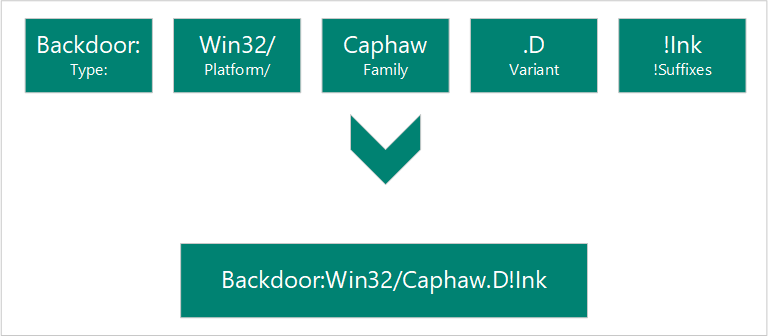Namen der Schadsoftware
Wir nennen die Schadsoftware und unerwünschte Software, die wir nach dem Namensschema der Computer Antivirus Research Organization (CARO) Malware erkennen. Das Schema verwendet das folgende Format:

Wenn unsere Analysten eine bestimmte Bedrohung untersuchen, bestimmen sie den Namen der einzelnen Komponenten.
Typ
Beschreibt, was die Schadsoftware auf Ihrem Computer tut. Würmer, Viren, Trojaner, Backdoors und Ransomware sind einige der häufigsten Arten von Schadsoftware.
* Adware
* Backdoor
* Behavior
* BrowserModifier
* Constructor
* DDoS
* Exploit
* HackTool
* Joke
* Misleading
* MonitoringTool
* Program
* Personal Web Server (PWS)
* Ransom
* RemoteAccess
* Rogue
* SettingsModifier
* SoftwareBundler
* Spammer
* Spoofer
* Spyware
* Tool
* Trojan
* TrojanClicker
* TrojanDownloader
* TrojanNotifier
* TrojanProxy
* TrojanSpy
* VirTool
* Virus
* Worm
Plattformen
Plattformen leiten die Schadsoftware auf ihr kompatibles Betriebssystem (z. B. Windows, macOS und Android) weiter. Die Anleitung der Plattform wird auch für Programmiersprachen und Dateiformate verwendet.
Betriebssysteme
* AndroidOS: Android operating system
* DOS: MS-DOS platform
* EPOC: Psion devices
* FreeBSD: FreeBSD platform
* iOS: iPhone operating system
* Linux: Linux platform
* macOS: MAC 9.x platform or earlier
* macOS_X: macOS X or later
* OS2: OS2 platform
* Palm: Palm operating system
* Solaris: System V-based Unix platforms
* SunOS: Unix platforms 4.1.3 or lower
* SymbOS: Symbian operating system
* Unix: general Unix platforms
* Win16: Win16 (3.1) platform
* Win2K: Windows 2000 platform
* Win32: Windows 32-bit platform
* Win64: Windows 64-bit platform
* Win95: Windows 95, 98 and ME platforms
* Win98: Windows 98 platform only
* WinCE: Windows CE platform
* WinNT: WinNT
Skriptsprachen
* ABAP: Advanced Business Application Programming scripts
* ALisp: ALisp scripts
* AmiPro: AmiPro script
* ANSI: American National Standards Institute scripts
* AppleScript: compiled Apple scripts
* ASP: Active Server Pages scripts
* AutoIt: AutoIT scripts
* BAS: Basic scripts
* BAT: Basic scripts
* CorelScript: Corelscript scripts
* HTA: HTML Application scripts
* HTML: HTML Application scripts
* INF: Install scripts
* IRC: mIRC/pIRC scripts
* Java: Java binaries (classes)
* JS: JavaScript scripts
* LOGO: LOGO scripts
* MPB: MapBasic scripts
* MSH: Monad shell scripts
* MSIL: .NET intermediate language scripts
* Perl: Perl scripts
* PHP: Hypertext Preprocessor scripts
* Python: Python scripts
* SAP: SAP platform scripts
* SH: Shell scripts
* VBA: Visual Basic for Applications scripts
* VBS: Visual Basic scripts
* WinBAT: Winbatch scripts
* WinHlp: Windows Help scripts
* WinREG: Windows registry scripts
Makros
* A97M: Access 97, 2000, XP, 2003, 2007, and 2010 macros
* HE: macro scripting
* O97M: Office 97, 2000, XP, 2003, 2007, and 2010 macros - those that affect Word, Excel, and PowerPoint
* PP97M: PowerPoint 97, 2000, XP, 2003, 2007, and 2010 macros
* V5M: Visio5 macros
* W1M: Word1Macro
* W2M: Word2Macro
* W97M: Word 97, 2000, XP, 2003, 2007, and 2010 macros
* WM: Word 95 macros
* X97M: Excel 97, 2000, XP, 2003, 2007, and 2010 macros
* XF: Excel formulas
* XM: Excel 95 macros
Andere Dateitypen
* ASX: XML metafile of Windows Media .asf files
* HC: HyperCard Apple scripts
* MIME: MIME packets
* Netware: Novell Netware files
* QT: Quicktime files
* SB: StarBasic (StarOffice XML) files
* SWF: Shockwave Flash files
* TSQL: MS SQL server files
* XML: XML files
Familie
Gruppierung von Schadsoftware basierend auf allgemeinen Merkmalen, einschließlich der Zuordnung zu denselben Autoren. Sicherheitssoftwareanbieter verwenden manchmal unterschiedliche Namen für die gleiche Malware-Familie.
Variant-Buchstabe
Wird sequenziell für jede einzelne Version einer Malware-Familie verwendet. Beispielsweise wäre die Erkennung für die Variante ".AF" nach der Erkennung für die Variante "" erstellt worden . AE".
Suffixe
Enthält zusätzliche Details zur Schadsoftware, einschließlich ihrer Verwendung als Teil einer Bedrohung mit mehreren Komponenten. Im vorherigen Beispiel gibt "!lnk" an, dass die Bedrohungskomponente eine von Trojan verwendete Tastenkombinationsdatei ist: Win32/Reveton.T.
* .dam: damaged malware
* .dll: Dynamic Link Library component of a malware
* .dr: dropper component of a malware
* .gen: malware that is detected using a generic signature
* .kit: virus constructor
* .ldr: loader component of a malware
* .pak: compressed malware
* .plugin: plug-in component
* .remnants: remnants of a virus
* .worm: worm component of that malware
* !bit: an internal category used to refer to some threats
* !cl: an internal category used to refer to some threats
* !dha: an internal category used to refer to some threats
* !pfn: an internal category used to refer to some threats
* !plock: an internal category used to refer to some threats
* !rfn: an internal category used to refer to some threats
* !rootkit: rootkit component of that malware
* @m: worm mailers
* @mm: mass mailer worm